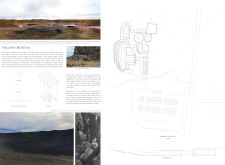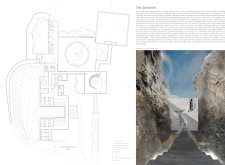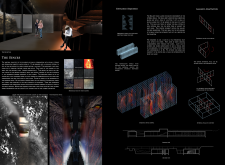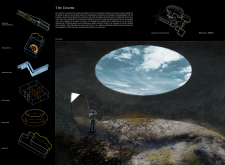5 key facts about this project
The Volcano Museum is an architectural project located in Hverfjall Crater, Iceland. It serves as a cultural and educational facility focused on Iceland's unique geology and rich folklore, which integrates elements of the natural landscape with the structure itself. The design emphasizes a deep connection to the region’s volcanic activity and serves to educate visitors about both the geological processes involved and the mythical narratives tied to the Icelandic terrain.
The museum's primary function is to provide a space for exhibitions, research, and public engagement regarding volcanic activity, promoting environmental awareness and cultural discourse. The architecture is designed to enhance the visitor experience, creating an immersive environment that encourages exploration and learning.
Material Choices and Structural Elements
The material palette is carefully selected to resonate with the geological context. Black steel is used for framing and structural elements, conveying strength, while dark concrete highlights the raw, volcanic characteristics of the site. Charred wood reflects traditional building practices and adds textural depth, while copper elements develop a natural patina over time, aligning with the theme of geological transformation. Translucent panels are incorporated throughout to create an interplay of light and shadow, fostering a dynamic atmosphere within the museum.
The spatial organization includes a welcoming reception area that prepares visitors for their journey through the museum. A central gallery space, adaptable for various exhibitions, facilitates educational programming and interactive displays. The unique geometric configuration of the building corresponds to the crater's shape, enhancing the site's natural topography and providing a contextual backdrop for the museum’s narrative.
Integration of Mythology and Geology
This project stands out through its integration of local mythology with geological education. The design concept references Icelandic folklore, creating a narrative thread throughout the museum that invites visitors to explore the intersection of myth and nature. This duality fosters a deeper understanding of both geological processes and cultural heritage.
The central space, resembling a crater, is designed to symbolize the earth's dynamic forces. It serves as a focal point, drawing visitors into the core themes of the museum. This feature highlights the visitor experience by creating an environment that is both contemplative and informative.
Unique architectural ideas are evident in the emphasis on sustainability and local craftsmanship. The use of locally-sourced materials and traditional building methods reflects a commitment to environmental responsibility. Additionally, the design allows for natural ventilation and passive solar heating, further minimizing the project's ecological footprint.
For a complete understanding of the architectural design, including detailed architectural plans, sections, and further insights into innovative design approaches, the presentation of the Volcano Museum offers valuable resources. It invites exploration of the spaces, materials, and architectural ideas that together create a distinctive intersection of culture, nature, and design.





















































